The New York City Ballet’s Fall Gala
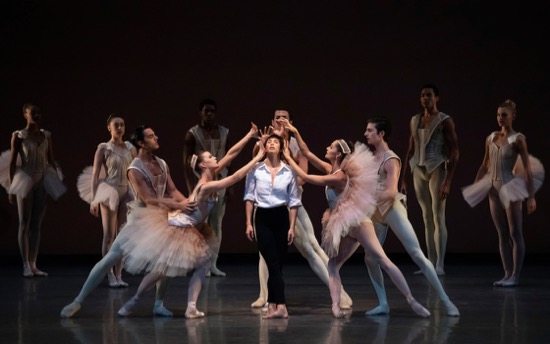
You can discover online a photo of Sarah Jessica Parker, swirling the yards of fuschia material in which designer Zac Posen had garbed her for the New York City Ballet’s Fashion Gala (she was one of six Gala chairpeople). The September 26th event— the eighth of its kind for NYCB— garnered 2.6 million dollars and occasioned the premieres of two new ballets: Lauren Lovette’s The Shaded Line (with costumes by Posen) and Edwaard Liang’s Lineage (with costumes by Anna Sui). A very in-house affair, since Lovette is a principal dancer in NYCB as well as a talented choreographer, and Liang, the artistic director of Columbus, Ohio’s BalletMet, was once a soloist in NYCB. The program ended with the company’s co-founder, George Balanchine’s great 1947 Symphony in C.
Brought up on story ballets in his native Russia, Balanchine knew how to spin a tale. His Apollo comes to mind. So do Bugaku, Night Shadow (aka La Somnambula), and others, but he preferred to let movement and designs in space evoke feelings obliquely. Lovette became a choreographer decades later, when literature sometimes twists and upends traditional narrative structure. The Shaded Line, her third work for NYCB, is as ambiguous as its title and a lot fiercer.The accompaniment, Tan Dun’s violin concerto, Fire Ritual (with Kurt Nikkanen as the soloist), has its gentle moments, but is also ferocious, complex in its texture; both the musicians and the dancers cry out, yell; you can imagine flames.
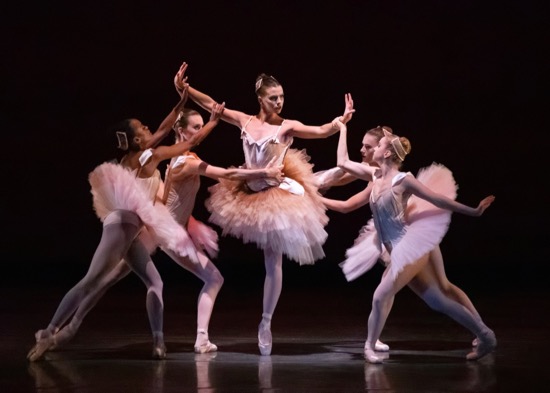
Lovette has assembled a small army of dancers: twelve women, eight men, and four principal dancers (three women and one man): Georgina Pazcoguin, Mary Thomas MacKinnon, Unity Phelan, and Taylor Stanley. Pazcoguin is the central figure, the seeker. As The Shaded Line begins, everyone else onstage is frozen, as if waiting for her to bring them to life. . .or into memory. The other three principals may be her alter egos. In Lovette’s tilted world, the subject could be gender and its issues—the “shaded line” to which the title refers. Pazcoguin wears black pants, a white shirt, and black pointe shoes; a short wig confines her hair. During the course of the ballet, she removes the shoes and dances barefoot, but later puts them on again.
Posen’s costumes for the other women suggest ballet attire turned inside out and upside down; they affirm what may also be a theme in the work: ballet as nightmare. Their short tutus are open in front and slant upward in back; when a dancer turns away from the audience, we see net arcing over a white-clad butt (only MacKinnon has a longer, more fully fledged tutu). The bodices for the women and the vests for the men resemble corsets. (Director of Costumes Marc Happel and his staff, who figure in the backstage film that opened the evening, faced the challenge with their predictable expertise).
All the dancers performed wonderfully, wholeheartedly, Pazcoguin showing both her expertise and her character’s confusion. Over the course of the dance, she partners the principal women, is surrounded, confronted, lifted high, shaken, dragged across the floor, and (maybe) crowned. She and Stanley dance in unison (affirming—or exploring— her male-ness?). Sometimes she calls out words that I can’t quite decipher. At least once, everyone else goes crazy (in her mind?). At the end of the ballet, she is alone onstage. On pointe. I wonder if the NYCB might reverse its aversion to program notes and allow Lovette a very tiny explanation of what we were about to see.
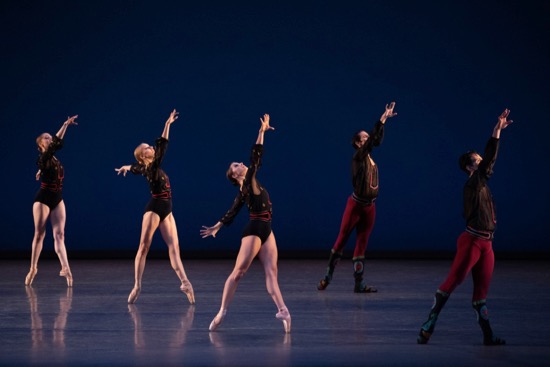
Edwaard Liang is a more experienced choreographer than Lovette. He has created works for numerous companies, both in the United States and abroad. His Lineage features four principal couples, two secondary ones, and four additional ones. Its score, Apollo, by the youngish British composer Oliver Davis—like Dun’s music that accompanies Lovette’s ballet—features a solo violinist (Arturo Delmoni), and it is that instrument’s voice that is heard as the ballet begins. Mark Stanley (who lit both the new works) creates a red dawn to which the dancers seem to awaken. Anna Sui’s costumes evoke a sophisticated and nameless peasant culture, with boots for the men and (initially) vividly flowered skirts for the women that they hold out as they dance. It’s not surprising that these celebrants first come together in a circle.
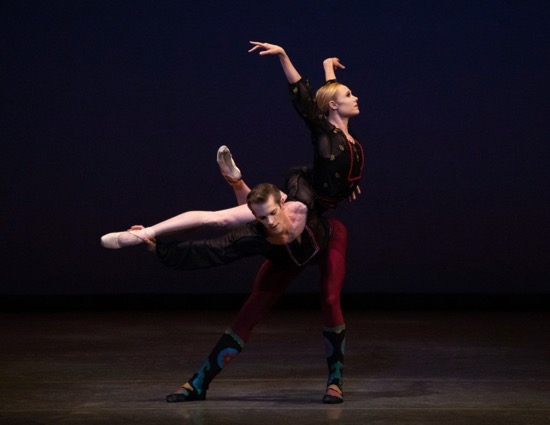
The mood is upbeat, sometimes athletic, with men somersaulting and couples vaulting past. The dancers may crouch, looking almost predatory, but they’re more likely to burst and spin into the air. Tyler Angle swings his partner, tall Maria Kowroski, by hooking an arm under her knees and when they finished their duet, rushing offstage with her in his arms. Duets emerge from the busy, festive gathering, as if two people were taking a much-needed moment to be alone together. Ashley Bouder and Peter Walker are quick-witted and fleet, Sara Mearns and Russell Janzen slower and tenderer in very imaginative ways. (Mearns is exemplary in the attention she pays her partner—not just he-who-lifts but a man she loves who reciprocates in kind.) Indiana Woodward is attended by the gifted young corps member, Roman Mejia.
Liang’s title Lineage acknowledges his previous experience as an NYCB dancer. He explained in a podcast that his homage to Balanchine is expressed in the dancers’ occasional assembling in a corner of the stage to gaze into one of the wings—maybe not the wing where the master usually sat watching, but symbolic none the less. What would he have thought?
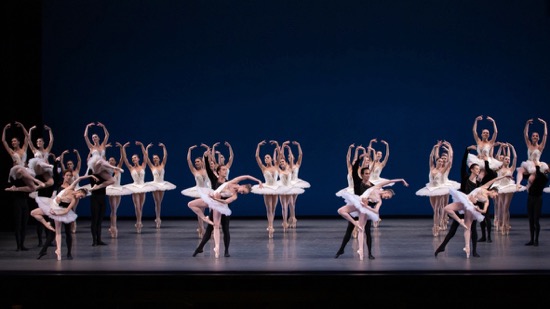
The last ballet of the evening, Symphony in C, was not the icing on a cake, but a beautiful mountain worth climbing. In 1946, when Balanchine first set the work for the Paris Opera Ballet, he called it Le Palais de Crystal. In 1947, its costumes and décor were simplified, and it took its title from the accompanying symphony, written by Georges Bizet when the composer was seventeen years old. Each of the ballet’s four movements is led by one principal couple (usually center) and two secondary ones (most often one on either side), backed up by either six or eight women. Its original title still lingers in its structure: Symphony in C is as symmetrical as a cut diamond. If there are three women on the left of the stage, there are inevitably three on the right. As the dancers reconfigure the space, it’s as if a book were opening and closing. And when, in the last movement, what seems like a forest of women lines up on either side of the stage, the white-clad women outnumber the dozen black-clad men, whom you’re seeing together onstage for the first time. (No wonder a memory of Swan Lake slips into my mind, even though Happel’s tutus are a more complicated than the usual image of un-broken whiteness).
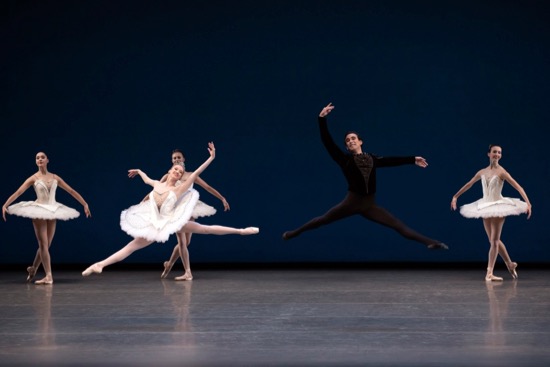
At the Gala, Megan Fairchild and Joseph Gordon led the first movement: Allegro Vivo. And Baily Jones and Sebastian Villarini-Velez led the third: Allegro Vivace. The slight difference in terminology means that these last two are jumping and leaping almost throughout. The fourth movement, led by Erica Pereira and Andrew Scordato is dubbed Allegro Vivace too, but you hardly notice the speed of foot because of Balanchine’s savvy theatrical buildup of personnel and complexity.
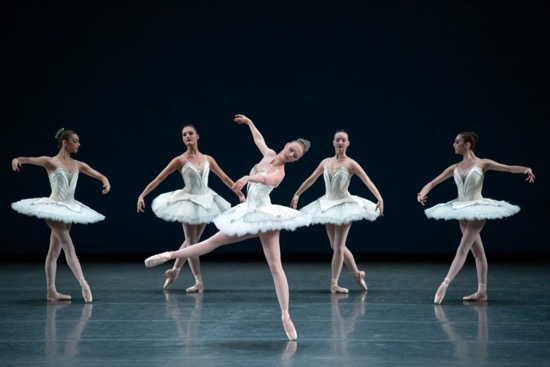
The second movement, an Adagio, is the one that can bring tears to your eyes. The line of six women forms diagonally for the first time, becoming an avenue for the secondary couples (Mimi Staker and Maxwell Read, Alston Macgill and Jonathan Fahoury) to progress along, arching their hands over the women’s heads. A similar diagonal line greets the principal couple (Teresa Reichlen and Jared Angle) as they enter together from a far corner. When Angle poses Reichlen, one couple swiftly circles them and returns to place. When he does it again, the other couple does the same thing. When he lifts her high and travels across the stage with her, the women of one pair make their arms into a basket for her to step down into. When he carries her in the opposite direction, the other two women oblige.
The symmetry and the repetitions aren’t at all boring. They honor tradition and reciprocity and have been set by Balanchine to Bizet’s score so beautifully, so musically that, despite the formality, they become strangely moving. As do Reichlen’s three suspended backward falls into Angle’s arms and the last moment when he slowly rotates and lowers her slanted body until he’s on one knee, and she is draped over his other one. They seem to have been seeking love as much as celebrating it.
And then the elegantly dressed audience dined and danced, while I went home full in another way.

Zac Posen and Anna Sui truly made the crossover between fashion and ballet wonderful.
Symmetrical and never boring.